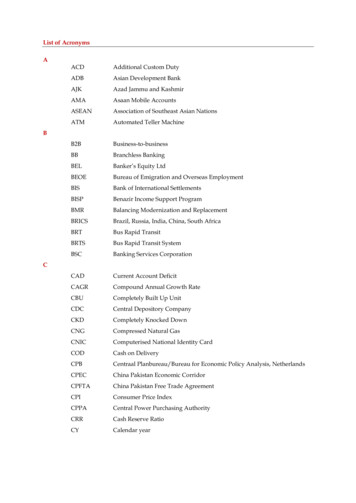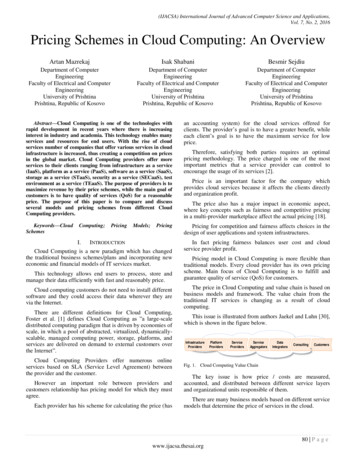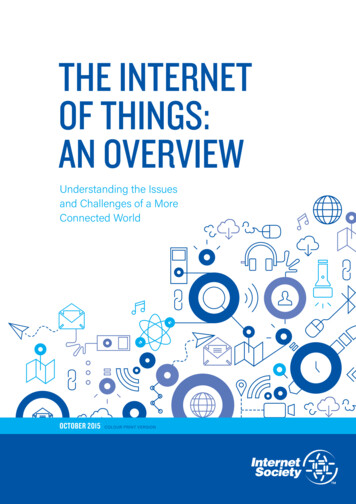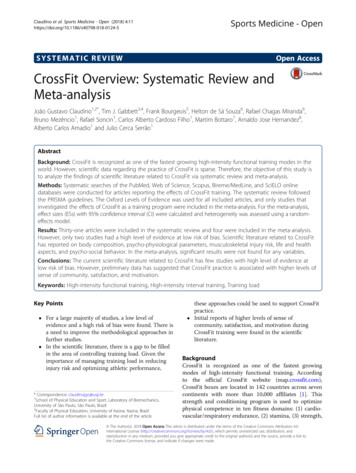
Transcription
An Overview ofInternational Cross Cultural ManagementAuthors: Dr. Hamid Doost Mohammadian
An Overview of International Cross Cultural ManagementAuthors:Dr. Hamid Doost Mohammadian12ABSTRACTEffective use of cross cultural teams can provide a source of experience and innovative thinking toenhance the competitive position of organizations. However, cultural differences can interfere with thesuccessful completion of projects in today’s multicultural global business community. To achieve project goals and avoid cultural misunderstandings, managers should be culturally sensitive and promotecreativity and motivation through flexible leadership. Managers in today’s multicultural global businesscommunity frequently encounter cultural differences, which can interfere with the successful completion of projects. Two leading studies of cross-cultural management have been conducted by Geert Hofstede3, and Fons Trompenaars4. Both approaches propose a set of cultural dimensions along which dominant value systems can be ordered. These value systems affect human thinking, feeling, and acting, andthe behavior of organizations and institutions in predictable ways. The two sets of dimensions reflectbasic problems that any society has to cope with but for which solutions differ. They are similar in somerespects and different in others. The dimensions can be grouped into several categories. Internationalization, often written as i18n, is the process through which products can be prepared to be taken to othercountries. It doesn’t just mean being able to change languages; instead it means being to accept differentforms of data, different settings to match local customs and different strings of data and process it correctly.Key words: International, Culture, Management, Cross Cultural1. History and conceptsInternational trade has a rich history starting with barter system being replaced by Mercantilism in the16th and 17th Centuries. The 18th Century saw the shift towards liberalism. It was in this period thatAdam Smith5., the father of Economics wrote about industrial revolution altered working conditionsand created large organizations; Adam Smith on the division of labor. In 1776 where in he defined the1Faculty member, researcher and lecturer at University of Applied Sciences (FHM), Berlin, GermanyWith special thanks to Mrs. Leyla Hakami, Master of Executive Business Administration, Tehran, Iran3Gerard Hendrik Hofstede (1928), Dutch social psychologist, former IBM employee, and Professor Emeritus ofOrganizational Anthropology and International Management at Maastricht University4Alfonsus (Fons) Trompenaars (1953), Dutch-French organizational theorist, management consultant, and authorin the field of cross-cultural communication.5Adam Smith ,Scottish economist(1723-1790)2
importance of specialization in production and brought International trade under the said scope. DavidRicardo6 developed the Comparative advantage principle, which stands true even today. All these economic thoughts and principles have influenced the international trade policies of each country. Thoughin the last few centuries, countries have entered into several pacts to move towards free trade where thecountries do not impose tariffs in terms of import duties and allow trading of goods and services to goon freely. The 19th century beginning saw the move towards professionalism, which petered down byend of the century. Around 1913, the countries in the west say extensive move towards economic libertywhere in quantitative restrictions were done away with and customs duties were reduced across countries. All currencies were freely convertible into Gold, which was the international monetary currencyof exchange. Establishing business anywhere and finding employment was easy and one can say thattrade was really free between countries around this period. The First World War changed the entirecourse of the world trade and countries built walls around themselves with wartime controls. Post worldwar, as many as five years went into dismantling of the wartime measures and getting back trade tonormalcy. But then the economic recession in 1920 changed the balance of world trade again and manycountries saw change of fortunes due to fluctuation of their currencies and depreciation creating economic pressures on various Governments to adopt protective mechanisms by adopting to raise customsduties and tariffs. The need to reduce the pressures of economic conditions and ease international tradebetween countries gave rise to the World Economic Conference in May 1927 organized by League ofNations where in the most important industrial countries participated and led to drawing up of Multilateral Trade Agreement. This was later followed with General Agreement of Tariffs and Trade (GATT)in 1947. However once again depression struck in 1930s disrupting the economies in all countries leading to rise in import duties to be able to maintain favorable balance of payments and import quotas orquantity restrictions including import prohibitions and licensing. Slowly the countries began to growfamiliar to the fact that the old school of thoughts were no longer going to be practical and that they hadto keep reviewing their international trade policies on continuous basis and this interns lead to all countries agreeing to be guided by the international organizations and trade agreements in terms of international trade. Today the understanding of international trade and the factors influencing global trade ismuch better understood. The context of global markets have been guided by the understanding and theories developed by economists based on Natural resources available with various countries which givethem the comparative advantage, Economies of Scale of large scale production, technology in terms ofe commerce as well as product life cycle changes in tune with advancement of technology as well as thefinancial market structures.6British political economist (1772-1823)
2. Theoretical Perspective of International tural communication: is defined as situated communication between individuals or groups of different linguistic and cultural origins.International Teamwork: Getting Cross-Cultural Teamwork Right. People struggle with global teamwork, even though it's essential to success in multinationalfirms. . They face conflicting group norms, practices, and expectations — all ofwhich can cause severe fracturing along cultural lines.Intercultural leadership: is a new leadership adapting to globalization wave andserving worldwide culture. . Under the background of global operation and globalization, intercultural leadership means leaders' leading competences across countries and all levels at organizations.Expatriate Management: an expatriate is an individual living in a country otherthan their country of citizenship, often temporarily and for work reasons. An expatriate can also be an individual who has relinquished citizenship in their homecountry to become a citizen of another.International HRM: IHRM can be defined as set of activities aimed managing organizational human resources at international level to achieve organizational objectives and achieve competitive advantage over competitors at national and international levelIntercultural Negotiation: involves discussions of common and conflicting interests between persons of different cultural backgrounds who work to reach an agreement of mutual benefit. International Business CommunicationInternational Strategy: business strategy refers to plans that guide commercialtransactions taking International place between entities in different countries. Typically, international business strategy refers to the plans and actions of private companies rather than governments; as such, the goal is increased profit.International Business Environment: from a business perspective, the primary incumbent in an international business environment is the multinational enterprise(MNE), which is a company that pursues strategic success in global productionand sales (i.e. operating within a number of country borders).
nagementInternationalBusiness EnvironmentInternationalHRMFigure 1: Theoretical Perspective of International Management Micro-/ Messo Levels: Intercultural Negotiation, Intercultural Communication, International Teamwork, Intercultural Leadership, Expatriate Management, International HRM, International Macro Levels: Business Environment, International Strategy3. Factors influencing International Management3.1.3.2.3.3.3.4.Legal system Legal system: refers to a procedure or process for interpreting andenforcing the law. It elaborates the rights and responsibilities in a variety of ways.Three major legal systems of the world consist of civil law, common law and religious law.State and political system: In terms of a political entity, a state is any politicallyorganized community living under a single system of government. States may ormay not be sovereign. For instance, federated states are members of a federal union,and may have only partial sovereignty, but are, nonetheless, states.Geography &Climate: the composite or generally prevailing weather conditionsof a region, as temperature, air pressure, humidity, precipitation, cloudiness, andwinds, throughout the year, averaged over a series of years. 2. a region or area characterized by a given climate.Culture& Religions: It can affect the same culture in different ways at differenttimes. When people in a culture believe strongly in a given religion, it can have a
3.5.3.6.huge impact on their culture. . This had a great effect on European culture of thetime. For example, almost all cultural expression was church-related.Taxation & Duties: Customs Duty is a tariff or tax imposed on goods when transported across international borders. The purpose of Customs Duty is to protect eachcountry's economy, residents, jobs, environment, etc., by controlling the flow ofgoods, especially restrictive and prohibited goods, into and out of the country.The economy: is defined as a social domain that emphasizes the practices, discourses, and material expressions associated with the production, use, and management of resources'.[1] Economic agents can be individuals, businesses, organizations, or governments. Economic transactions occur when two parties agree to thevalue or price of the transacted good or service, commonly expressed in a certaincurrency. Monetary transactions only account for a small part of the economic domain.State and political systemLegal systemRule of law generalStability and predictabilityContract, trade and patent lawOpen vs hidden political powersLabour, environment lawBureaucracy and red tapeDue process in administrationProperty and property protectionrestrictons to free movementSystem of courts and arbitrationsstakeholders, supporters and adversariesex-and import restrictionsinformal laws,corruptionGography & climateTopography and distancesTemperatures and precipationNature and wildwifeSpecific health risk or benefitsEtc.Etc.informal tate of economy in generalTaxation & DutiesTaxes and tax ratesTransport and communicationsinfrastructureEx- and import tarrffsAvailability of supply chainSpecific taxes on foreignersAvailability of skilled labourEtc.Subsidies and tax breaksCulture and religionsLanguages and availability of translatorsReligious rules and restrictionsCustomers and traditionsSpecific sensitivitiesGender equalityLabour costs and costs of livingMentality and mindsetsAttractive places to liveManagement styles, customaryEtc.Roles and behavioral patternsCollective Vs individualistic valuesFigure 2: Factors influencing International Management
International Business Environment (Culture):The International Environment. . Managing a business in a foreign country requires managers to deal with a large variety of cultural and environmental differences. As a result, international managers must continually monitor the political,legal, sociocultural, economic, and technological environments.ReligionSacred objectsPhilosophical systemsPrayerValues andAttitudes TowardsLanguageTaboosSpoken languageHolidaysWritten languageScientific methodRitualsAchievementOfficial languageRisk-takingLinguistic pluralismEducationInternational languageSecondary educationVocational traininglawFormal educationINTERNATIONALBUSINESSENVIRONMENThome country lawInternational lawcommon law(CULTURE)foreign lawforeign lawHuman resourcesHigher educationLiteracy levelplanningSocial Organizationcode lawAuthority structuresforeign lawregulationPrimary educationSocial stratificationPoliticsNational interestsPolitical riskNationalismImperialismSocial institutionsStatus systemsTechnology andMaterial CultureInterest sEnergy systemsPowerTools & objectsUrbanizationinventionFigure 3: International Business Environment (Culture)Social mobility
4. International Cross Cultural ManagementManaging cross-cultural challenges in the international business management is akin to the "Hygiene"factor of the "Dual-factor Motivation" theory. In management of international business, embracing thecultural diversity of the country may or may not bring success, but not doing so will surely increase thechances of stagnation or failure. The world is becoming smaller day-by-day and therefore, the entrepreneurs & managers involved in the international businesses will have to become more sensitive to thechallenges emanating from the cultural and ethnic landscape of the countries they work in. In the last 2decades, cross-cultural challenges in the international business management have become prominent asthe companies have started expanding across the territorial boundaries. Even leading managementschools have started incorporating cross-cultural challenges as part of the curriculum of the internationalbusiness management.4.1.What is "Culture"?Culture is the "acquired knowledge that people use to anticipate events and interpret experiences forgenerating acceptable social & professional behaviors. This knowledge forms values, creates attitudesand influences behaviors". Culture is learned through experiences and shared by a large number of people in the society. Further, culture is transferred from one generation to another.In the figure below, it is specified that what are the elements of the culture?
Das Bildelement mit der Beziehungs-ID rId1 wurde in der Datei nicht odjokesfoodCelebrationsFolk ArtFigure 4: Culture4.2.What are the core components of "Culture"?4.2.1.4.2.2.4.2.3.4.2.4.4.2.5.Power distribution - Whether the members of the society follow the hierarchical approach or the egalitarian ideology?Social relationships - Are people more individualistic or they believe in collectivism?Environmental relationships - Do people exploit the environment for theirsocioeconomic purposes or do they strive to live in harmony with the surroundings?Work patterns - Do people perform one task at a time or they take up multiple tasks at a time?Uncertainty & social control - Whether the members of the society like toavoid uncertainty and be rule-bound or whether the members of the societyare more relationship-based and like to deal with the uncertainties as &when they arise?
Figure 5: Iceberg of Culture4.3.What are the critical issues that generally surface in cross-cultural teams?4.3.1.4.3.2.4.3.3.4.3.4.Inadequate trust - For example, on one hand a Chinese manager wonderswhy his Indian teammates speak in Hindi in the office and on the other hand,his teammates argue that when the manager is not around, why they can'tspeak in English?Perception - For instance, people from advanced countries consider peoplefrom less-developed countries inferior or vice-versa.Inaccurate biases - For example, "Japanese people make decisions in thegroup" or "Indians do not deliver on time", are too generalized versions ofcultural prejudices.False communication - For example, during discussions, Japanese peoplenod their heads more as a sign of politeness and not necessarily as an agreement to what is being talked about.
Table 1: Western Vs Non-Western4.4.What are the communication styles that are influenced by the culture of thenation?4.4.1.4.4.2.4.4.3.4.4.4.4.5.'Direct' or 'Indirect' - The messages are explicit and straight in the 'Direct'style. However, in the 'Indirect' style, the messages are more implicit & contextual.'Elaborate' or 'Exact' or 'Succinct' - In the 'Elaborate' style, the speaker talksa lot & repeats many times. In the 'Exact' style, the speaker is precise withminimum repetitions and in the 'Succinct' style; the speaker uses fewerwords with moderate repetitions & uses nonverbal cues.'Contextual' or 'Personal' - In the 'Contextual' style, the focus is on the speaker's title or designation & hierarchical relationships. However, in the 'Personal' style, the focus is on the speaker's individual achievements & there isminimum reference to the hierarchical relationships.'Affective' or 'Instrumental' - In the 'Affective' style, the communication ismore relationship-oriented and listeners need to understand meanings basedon nonverbal clues. Whereas in the 'Instrumental' style, the speaker is moregoal-oriented and uses direct language with minimum nonverbal cuesWhat are the important nonverbal cues related to the communication amongcross-cultural teams?4.5.1.Body contact - This refers to the hand gestures (intended / unintended), embracing, hugging, kissing, thumping on the shoulder, firmness of handshakes, etc.
4.5.2.4.5.3.Interpersonal distance - This is about the physical distance between two ormore individuals. 18" is considered an intimate distance, 18" to 4' is treatedas personal distance, 4' to 8' is the acceptable social distance, and 8' is considered as the public distance.Cross-cultural challenges in international business management", has become a keenly followed topic in last two decades. There are enough examples of business failures or stagnation or failure of joint ventures, on accountof the management's inability to recognize cross-cultural challenges andtackle them appropriately. There are also examples of companies havingcompulsory training on culture management or acculturation programs foremployees being sent abroad as or hired from other countries, to ensure thatcross-challenges are tackled effectively.5. Strategy for International Cross Cultural Management - Cross Cultural Differences (Cultural dimension)1. Individualism / Collectivism2. Power Distance3. Uncertainty Avoidance4. Quality Versus / Quantity of LifeIndividualism, versus its opposite, collectivism, is the degree to which individuals are supposed to look after themselves or remain integrated into groups, usuallyaround the family. Positioning itself between these poles is a very basic problem allsocieties face. A concise definition is: “Individualism stands for a society in whichthe ties between individuals are loose: Everyone is expected to look after him/herself and her/his immediate family only. Collectivism stands for a society in whichpeople from birth onward are integrated into strong, cohesive in-groups, whichthroughout people’s lifetime continue to protect them in exchange for unquestioning loyalty” [4]. National differences in Individualism are calculated in an Individualism Index (IDV). The highest IDV scores were found in the United States, Australia, and Great Britain. The lowest IDV scores were found in Guatemala, Ecuador,and Panama.Individualism (USA) / Collectivism (Japan or China-family, social network and friendsare very important).In fact the representative of Individualism is USA that the opposite of Japan Whichsymbolizes of collectivism.5.1.
FFFFigure 6: Individualism vs Collectivism7Each individual is connected to a very complex net of relationship. In sch cultures and countries,communication is the first word and it’s major cause for success Business.Cross- Cultural Differences ( Cultural Dimension)Individualism (USA) / Collectivism (Japan or China) – these are the most common onesIt has long been believed that the Japanese are more collectivistic than the Americans.To assess the validity of this common view, the based on 15 empirical studies that compared these two nations on individualism/collectivism. Surprisingly, 14 studies did notsupport the common view; the only study that supported it turned out to bear little relevance to the ordinary definition of individualism/collectivism. An examination of thesupportive evidence of the common view disclosed that this view had been formed onan unexpectedly flimsy ground. It further turned out that the wide acceptance of thecommon view may have been the result of the fundamental attribution error, which mayhave led to an underestimation of situational factors in interpreting the past obviouslycollectivistic behaviour of the Japanese.5.1.1.USACULTURALCONTEXTself- General lfreedom,opposing interestsJAPANcollective, consensusand cooperation oriented,embeddedness in society,harmonyLow power distance,low Geert hofstede:uncertainty avodiance, very Culture's Consquenceshigh individualism and highmasculinityHigh power distance,Very high uncertaintyAvoidance,lowindividualismAnd very high masculinityUniversalism,individualism, Fons trompenaars:Particularismemotional relations,specific Riding the waves of Collectivism, neutralcultureculturesRelations, vague cultureTable2: The state of America and Japan in terms of individualistic culture7Source, Yang Liu
Collectivists focus on communal, societal, or national interests in various types of political, economicand educational systems and that's the opposite of Individualistic.5.2.Power Distance (distance between you and your boss)Power distance is the extent to which the less powerful members of organizations and institutions accept and expect that power is distributed unequally. Thebasic problem involved is the degree of human inequality that underlies the functioning of each particular society. In Hofstede’s research, power distance ismeasured in a Power Distance Index (PDI). The values and attitudes found atthe national level contrast “low-PDI countries” with “high-PDI countries”, withsome countries placed in between. High PDI countries include Malaysia andMexico. Low PDI countries include Austria and Denmark.A high PDI score indicates that a society accepts an unequal, hierarchical distribution of power,and that people understand "their place" in the system. A low PDI score means that power isshared and is widely dispersed, and that society members do not accept situations where poweris distributed unequally. Application: According to the model, in a high PDI country, such as Malaysia (100),team members will not initiate any action, and they like to be guided and directed tocomplete a task. If a manager doesn't take charge, they may think that the task isn't important.Diagram1: power distance vs. Individualist
5.3.Uncertainty (Risk) AvoidanceRefers to the extent to which a culture programs its members to feel either uncomfortable orcomfortable in unstructured situations. Unstructured situations are novel, unknown, surprising,and different from usual. The basic problem involved is the degree to which a society tries tocontrol the uncontrollable. The countries from Hofstede’s study were each given a score onUncertainty Avoidance Index (UAI). UAI was derived from country mean scores on questionsdealing with rule orientation, employment stability, and stress. Hofstede’s research has foundUAI values for 50 countries and three regions. The countries rank from Greece, Portugal, andGuatemala (highest UAI) to Singapore, Jamaica, and Denmark (lowest UAI).5.3.1.5.3.2.Uncertainty avoidance is one of five key qualities or dimensions measuredby the researchers to understand why some ideas and business practiceswork better in some countries than the others.The uncertainty avoidance dimension expresses the degree to which a typical person in a society feels uncomfortable with a sense of uncertainty andambiguity (fuzzy).In cross-cultural psychology, uncertainty avoidance is a society's tolerance for uncertainty andambiguity. It reflects the extent to which members of a society attempt to cope with anxiety byminimizing uncertainty.The research show People in cultures with high uncertainty avoidance tend to be more rational.They try to minimize the occurrence of unknown and unusual circumstances and to proceedwith careful changes step by step by planning and by implementing rules, laws and regulations.In contrast, low uncertainty avoidance cultures accept and feel comfortable in unstructured situations or changeable environments and try to have as few rules as possible. People in thesecultures tend to be more pragmatic and more tolerant of change. This dimension describes howwell people can cope with anxiety. In societies that score highly for Uncertainty Avoidance,people attempt to make life as predictable and controllable as possible. If they find that theycan't control their own lives, they may be tempted to stop trying. These people may refer to"mañana," or put their fate "in the hands of God "People in low UAI-scoring countries are morerelaxed, open or inclusive. Bear in mind that avoiding uncertainty is not necessarily the same asavoiding risk. Hofstede argues that you may find people in high-scoring countries who are prepared to engage in risky behavior, precisely because it reduces ambiguities, or in order to avoidfailure. Application: In Hofstede's model, Greece tops the UAI scale with 100, while Singaporescores the lowest with eight. Therefore, during a meeting in Greece, you might be keen to generate discussion, because you recognize that there's a cultural tendency for team members tomake the safest, most conservative decisions, despite any emotional outbursts. Your aim is to
encourage them to become more open to different ideas and approaches, but it may be helpfulto provide a relatively limited, structured set of options or solutions.Diagram2: Uncertainty avoidance IndividualistMasculinity vs. Femininity ‘Quality/Quantity of Life’ Hofstede (2010) the distribution of emotional roles between the genders: whether people are motivated bywanting to be the best, or liking what they do Masculinity versus its opposite,femininity, refers to the distribution of emotional roles between the genders, whichis another fundamental problem for any society. This distinction opposes “tough”masculine and “tender” feminine societies. The duality of the sexes is a fundamental fact with which different societies cope in different ways. Surveys on theimportance of work goals show that almost universally women attach more importance to social goals such as relationships, helping others, and the physical environment, and men attach more importance to ego goals such as careers andmoney. However, Hofstede’s data revealed that the importance respondents attached to such “feminine” versus “masculine” work varied across countries as wellas across occupations. Masculinity stands for a society in which gender roles areclearly distinct. Men are supposed to be assertive, tough, and focused on materialsuccess. Women are supposed to be more modest, tender, and concerned with thequality of life. Femininity stands for a society in which gender roles overlap. Bothmen and women are supposed to be modest, tender, and concerned with the qualityof life. Because the respondents were mostly men, Hofstede suggested calling thisdimension the Masculinity Index (MAS). The list of countries in order of MAS(high gender roles distinction at work) shows Japan at the top. German-speakingcountries (Austria, Switzerland, and Germany) scored high; so did the CaribbeanLatin American countries Venezuela, Mexico, and Colombia, and Italy. The Anglo countries (Ireland, Great Britain, South Africa, the United States, Australia,New Zealand, and Canada) all scored above average. Asian countries, other thanJapan, were in the middle. The feminine side (low gender roles distinction at work)
includes other Latin countries (France, Spain, Salvador, etc.). At the extreme“feminine” pole were the Nordic countries including Sweden, Norway, and theNetherlands. Low MAS countries are characterized by cooperation at work and agood relationship with the boss, belief in group decisions, promotion by merit,lower job stress, and preference for smaller companies. High MAS countries arecharacterized by challenge and recognition in jobs, belief in individual decisions,higher job stress, and preference for large corporations.Masculine/ Quantity of life Cultures value are competitiveness /assertiveness materialism ambition and powerMore dramatic and less fluiddifference between genderrolesFeminine/Quality of life Cultures place more value onrelationship and quality of lifeMen and women have the samevalues emphasizing modestyand caringTable3: Masculinity vs. Femininity6. Danger of Sophisticated StereotypingFirst of all what is Stereotyping:6.1.6.2.6.3.6.4.6.5.6.6.A simplified representation which focuses on certain characteristics of a group andassumes these to be share across all group members.A stereotype is a preconceived notion, especially about a group of people.Stereotype is categories of objects and people.Sets of generalizations about the characteristics of individuals or groups of peopleand often destrted the representations.Sex, race, age, sexual orientation, religion and physical ability are various catagories which exist in stereotyping. The most prevalent and controvers
Intercultural communication: is defined as situated communication between in-dividuals or groups of different linguistic and cultural origins. 2.2. International Teamwork: Getting Cross-Cultural Teamwork Right. People strug-gle with global teamwork, even tho











